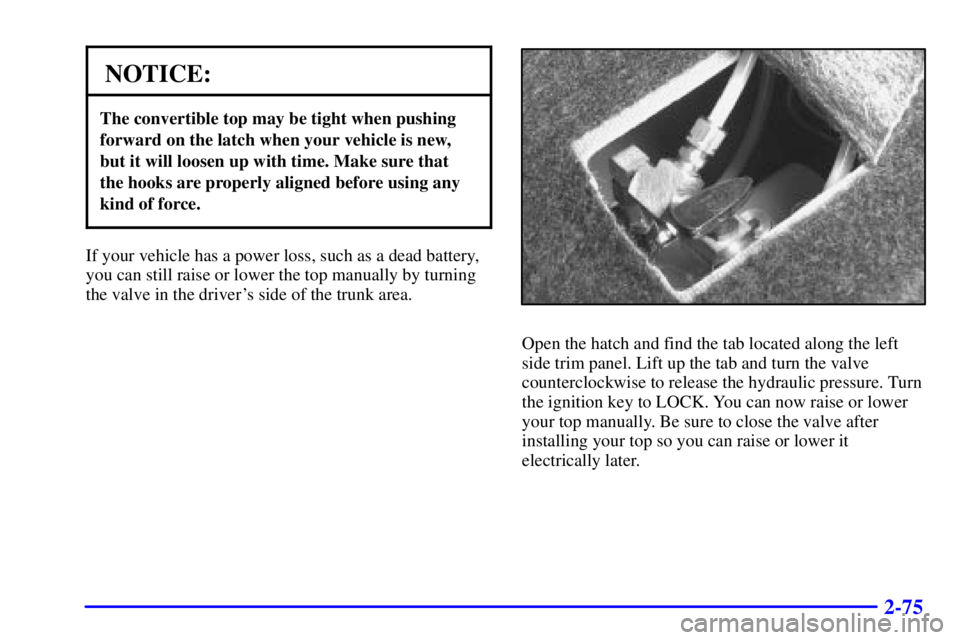PONTIAC FIREBIRD 2000 Owners Manual
FIREBIRD 2000
PONTIAC
PONTIAC
https://www.carmanualsonline.info/img/50/40811/w960_40811-0.png
PONTIAC FIREBIRD 2000 Owners Manual
Trending: oil pressure, jacking, reset, open gas tank, display, open hood, rear view mirror
Page 131 of 360
2-71
3. Install the two side covers by inserting the tab into
the front seatbelt cover. Lower the covers onto
the vehicle.4. Install the middle section of the cover by sliding the
tabs into the slots on the right side cover. Lower the
cover and insert the latch.
5. Close the hatch.
Page 132 of 360
2-72 Removing Your Boot Cover
1. Open the hatch. Remove the middle piece of the
cover by pushing in on the latch and lifting up on
the cover.
2. Remove the two side pieces of the boot cover by
lifting the rear cover and sliding them out of
their slots.
Page 133 of 360
2-73
3. Store each piece of the cover in its separate
compartment according to the graphic printed inside
of the storage bag. Store the bag in the trunk area
and close the hatch.
4. Disengage the two convertible top latches.
Raising Your Convertible Top
1. It is recommended that you park on a level surface.
Set the parking brake firmly. If you have an
automatic transmission, shift into PARK (P).
If you have a manual transmission, shift into
REVERSE (R).
2. Turn the ignition to ACC or RUN (or RAP must
be on).
3. Lower both sun visors and lower both windows at
least 3 inches (8 cm). If the boot cover is in place, it
must be removed first.
NOTICE:
It is not recommended that you raise or lower the
top while the vehicle is moving.
Page 134 of 360
2-74
4. Push and hold the
up arrow on the top
part of the convertible
TOP switch.
5. Pull down on the center opening and align the hooks
with the holes. Push forward on the larger part of the
latch until it clicks. Do not force the latch. If it is
hard to lock, the top is not properly aligned.
Page 135 of 360
2-75
NOTICE:
The convertible top may be tight when pushing
forward on the latch when your vehicle is new,
but it will loosen up with time. Make sure that
the hooks are properly aligned before using any
kind of force.
If your vehicle has a power loss, such as a dead battery,
you can still raise or lower the top manually by turning
the valve in the driver's side of the trunk area.
Open the hatch and find the tab located along the left
side trim panel. Lift up the tab and turn the valve
counterclockwise to release the hydraulic pressure. Turn
the ignition key to LOCK. You can now raise or lower
your top manually. Be sure to close the valve after
installing your top so you can raise or lower it
electrically later.
Page 136 of 360
2-76
The Instrument Panel -- Your Information System
Page 137 of 360
2-77
A. Fog Lamp Switch
B. Main Lamp Control
C. Air Vents
D. Instrument Panel Cluster
E. Horn
F. Audio System
G. Glove Box
H. Remote Hatch Release
I. Audio Steering Wheel Controls (If Equipped)
J. Rear Window Defogger ButtonK. Convertible Top Switch (If Equipped)
L. Traction Control System Switch (If Equipped)
M. Ashtray (Automatic Transmission)
N. Shift Lever (Automatic Transmission Shown)
O. Cupholders
P. Front Console
Q. Parking Brake Lever
R. Cigarette Lighter
S. Accessory Power Outlet
T. Comfort Controls
Page 138 of 360
2-78 Instrument Panel Cluster
Your instrument panel cluster is designed to let you know at a glance how your vehicle is running. You'll know how
fast you're going, your engine's rpms, about how much fuel you have left and many other things you'll need to know
to drive safely and economically.
5.7L V8 Engine Shown, 3800 V6 Engine Similar (United States Shown, Canadian Similar)
Page 139 of 360
2-79 Speedometer and Odometer
Your speedometer lets you see your speed in both miles
per hour (mph) and kilometers per hour (km/h). Your
odometer shows how far your vehicle has been driven,
in either miles (used in the United States) or kilometers
(used in Canada).
You may wonder what happens if your vehicle needs a
new odometer installed. If possible, the new one has to be
set to the same reading the old one had. If it can't be, then
it's set at zero, and a label on the driver's door must show
the old reading and when the new one was installed.Trip Odometer
The trip odometer can tell you how far your vehicle has
been driven since you last set the trip odometer to zero.
To set the trip odometer to zero, press the TRIP
OIL/RESET knob on the instrument panel cluster.
Page 140 of 360

2-80 Tachometer
The tachometer displays the engine speed in thousands
of revolutions per minute (rpm).
NOTICE:
Do not operate the engine with the tachometer in
the red area, or engine damage may occur.
Warning Lights, Gages and Indicators
This part describes the warning lights and gages that
may be on your vehicle. The pictures will help you
locate them.
Warning lights and gages can signal that something is
wrong before it becomes serious enough to cause an
expensive repair or replacement. Paying attention to
your warning lights and gages could also save you or
others from injury.Warning lights come on when there may be or is a
problem with one of your vehicle's functions. As you
will see in the details on the next few pages, some
warning lights come on briefly when you start the
engine just to let you know they're working. If you are
familiar with this section, you should not be alarmed
when this happens.
Gages can indicate when there may be or is a problem
with one of your vehicle's functions. Often gages and
warning lights work together to let you know when
there's a problem with your vehicle.
When one of the warning lights comes on and stays on
when you are driving, or when one of the gages shows
there may be a problem, check the section that tells you
what to do about it. Please follow this manual's advice.
Waiting to do repairs can be costly
-- and even
dangerous. So please get to know your warning lights
and gages. They're a big help.
Trending: octane, wiring, remote start, start stop button, oil type, gas type, service









